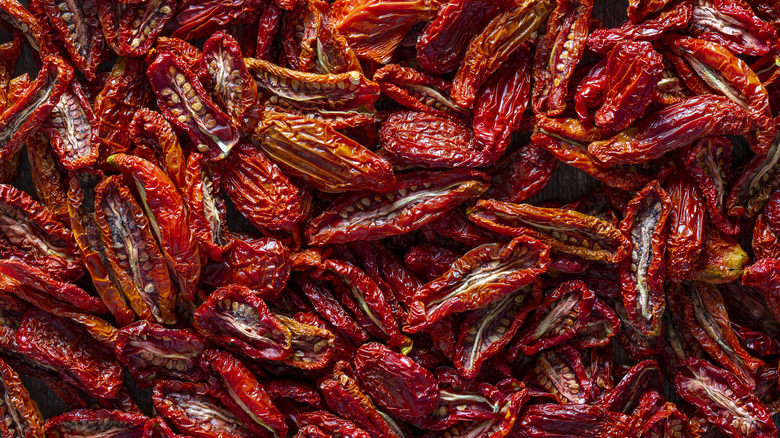The Best Varieties To Use For Better Tasting Sun-Dried Tomatoes
When the farmers of southern Italy learned to sun-dry their tomato crop in the long wake of its arrival to the country from the New World in the 1500s, the primary goal was preservation, not flavor. In a world without modern refrigeration, drying offered a way for people to have enough to eat through the periods of the year when fresh food was less available, especially in winter. Indeed, this preservation technique for fruit, vegetables, and herbs goes back to ancient times, and even beyond. As the tomato developed over the subsequent centuries into the versions we have today and overcame people's fears of eating it, sun-drying naturally came in the process, delivering a more concentrated dose of tomato flavor that won converts quickly and exploded in popularity after it arrived in the United States in the late 1970s.
With more than 10,000 varieties of tomato available today, the challenge becomes choosing the best variety of tomatoes for the occasion. While taste is always subjective, the most popular types that deliver the more desired flavors include Roma, San Marzano, Principe Borghese, Amish Paste, Napoli, Big Mama, and Plum Regal. That's because these tomatoes are meaty and have a low water content, keeping them firmer and cohesive as they dry. Low water also translates to faster drying and fewer mold issues. Lastly, the longer, oval shape makes these varieties easier to handle than larger, round tomatoes, with large, wet seed pockets, which is another reason to consider size in choosing a tomato for sun-drying.
The difference the sun makes
As sun-dried tomatoes exploded in popularity in the 1990s, appearing on the menu at almost any hip restaurant, so did demand. This pushed many producers and distributers of sun-dried tomatoes to turn to commercial dehydrators, which dry tomatoes mechanically through a different, faster process. For many lovers of sun-dried tomatoes, this shift robbed a significant amount of the flavor and texture to leave them more bitter, less fleshy, and worse tasting — even spurring two-time James Beard Award winner Chef Joyce Goldstein to call them, "damned dehydrated tomatoes." Nevertheless, the process may welcome more tomato varieties than usual, as do drying tomatoes in the air fryer and oven.
When choosing the best tomatoes to sun-dry, you should also look for ones that are sun-grown. That's because, as any bite of a vegetable fresh from the garden proves, the sun imbues fruits and vegetables with stronger and better flavors. Natural sunlight maximizes photosynthesis, helping the tomato make the carbohydrates that transform into sugars, acids, and other flavor compounds — more so than artificial light. Natural sunlight also provides all the wavelengths plants need to grow strong through their whole life, leading to better taste compared to dehydrated. Organic tomatoes may also fare better for sun-drying, as the lower nitrate levels and smaller yields in organic farming often improve the level of nutrients and flavor, making a better tasting sun-dried tomato in dishes like sun-dried tomato pesto pasta and spinach and sun-dried tomato puffs.

